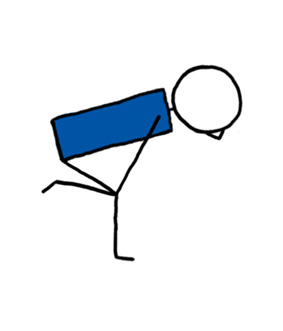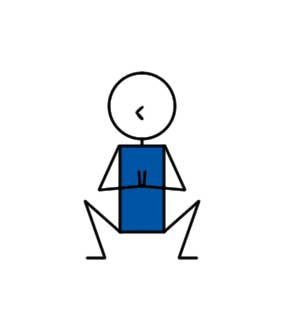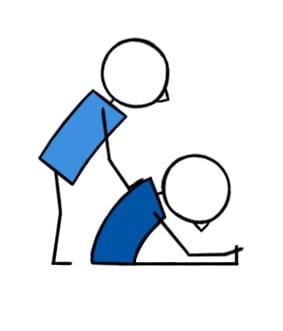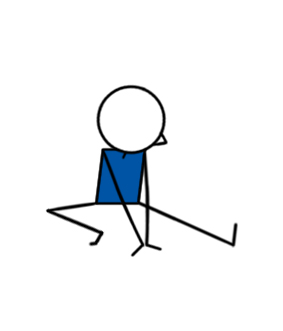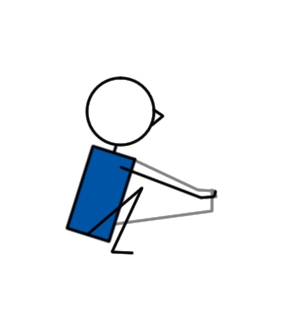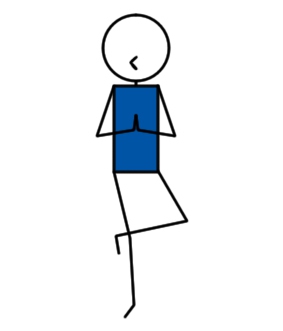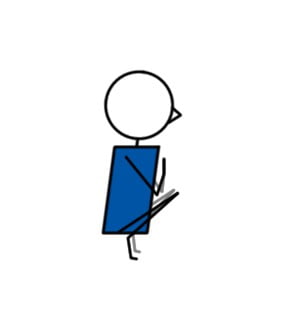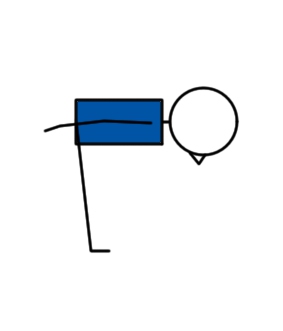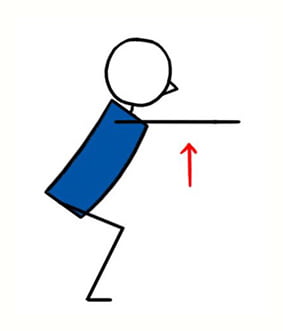
| Category: | Yoga Lesson Planner |
|---|---|
| Sub Category: | Standing |
| Types: | Balance, Hip Opener, Standing, Stretch |
| Anatomy: | Arms & Shoulders, Hamstrings, Hips, Knees, Psoas, Wrists & Arms |
| Chakras: | Base, Sacral Centre, Solar Plexus Centre |
| Therapy: | Back Pain, Poor Posture |
| Drishti: | Tip Of Nose |
| Dosha: | Kapha, Pitta |
| Meridian Lines: | Stomach |
Stand in mountain pose. Widen stance and splay feet open a bit. Squat down with feet shoulder width apart. Instead of slowly rising as with a traditional squat, jump into the air with core engaged and land in a squat position. Repeat.
Build strength, power, endurance.
A) Sit on the front edge of a chair. B) Folded blanket under heels. C) Lift all ten toes up. D) Bring arms to tops of legs and reach outward. E) Sit back against a wall like you are in a chair. F) Add a twist. G) Sit on a block. H) Roll a blanket and place it in the crease of both knees.
Knee injury.
Click here for lots of FREE downloadable Yoga lesson plans.
Click here for lots of FREE downloadable Pilates lesson plans.
- MedYoga: Beginners Postures
- Advansed
- Cool start, dynamic middle and Partner Yoga to have a good time
- Lower Body Focus
- Lower Body Monday
- Ask Genie1
- Toxin Release - flow
- Week 1: Hatha Yoga Beginners
- vinyasa slow flow
- Toxin Release - Copy
- Ask Genie2
- Ask Genie1
- vinyasa slow flow
- Solar Plexus Chakra
- Ask Genie1
- Solar Plexus Chakra
- vinyasa slow flow 2
- Yoga for Cyclists
- Shadows
- Ask Genie1
- All Levels Peak Pose Camel
- Yoga for Cyclists
- Ask Genie2
- Teachers Dec18 2017
- Ask Genie1
- 15 Minute Yoga: 136 Standing Poses
- Ask Genie10
- Flow with back bends 06-03-18
- Flow Gentle 12-03-18
- Standing - copy
- Yoga for Cyclists: In The Park
- 'May Day' Lesson Plan
- Standing II
- Tuesday 22 May
- Yoga for Cyclists: In The Park
- Yoga for Cyclists: In The Park 60min
- Cat/Cow ( Marjarasana/Bitilasana)
- Ask Genie27
- RLS Week 1: Locust Peak Pose
- Yoga for Cyclists: In The Park
- Yoga For Cyclists: 41 Post Ride Sequences
- Standing
- standing
- 2019 Week 31
- A gentle time
- Week of 10/1/19
- Yoga for Cyclists
- Yoga for Cyclists: In The Park
- Ask Genie3
- Yoga In The Park
- Ask Genie1
- Yoga for Cyclists
- Yoga for Cyclists
- Yoga For Cyclists: 41 Post Ride Sequences
- Yoga for Cyclists: In The Park
- Yoga In The Park
- Ask Genie1
- HIIT Wednesday 21July
- Ask Genie6
- Ask Genie1
- Weight Room 20-30 second holds
- Ask Genie3
- Locust Peak Pose
- Locust Peak Pose
- Ask Genie3
- WEEK FIVE WARM UP YOGA (HEART RAISER) INSTEAD OF (SUN SALUTATIONS)
- Ask Genie2
- WEEK FIVE WARM UP YOGA (HEART RAISER) INSTEAD OF (SUN SALUTATIONS)
- Yoga for Cyclists: In The Park
- Yoga For Cyclists: 41 Post Ride Sequences
- Ask Genie 7
- Yoga Sculpt
- Ask Genie 11
- Ask Genie 14
- Ask Genie 24
- Ask Genie 1
- Yoga For Cyclists: 41 Post Ride Sequences
- Piyo
- 15 Minute Yoga: 136 Standing Poses
- Francie 1
- Francie 1
- Back Bend Flow
- Modifikovaná Astanga na TT
- WEEK FIVE WARM UP YOGA (HEART RAISER) INSTEAD OF (SUN SALUTATIONS)
- Ask Genie 1
- 15 Minute Yoga: 136 Standing Poses
- Ask Genie 3
- Little Yogis Video Of Poses :)
- Ask Genie 3
Squat Pose FAQs
What is the Sanskrit of Squat Pose?
Malasana
You can get your students to remember the pose (when teaching a class) by turning “Malasana” into a mantra (if, for example, it’s the peak pose in your yoga lesson plan). During the rest postures (e.g. Child Pose, Extended Child Pose) or when they are performing Squat Pose, ask your students to repeat the word “Malasana” multiple times as a mantra.
What are other names for Squat Pose?
- Deep squat pose
- Garland pose
- Sitting down pose
- Upavesasana
What’s the most important thing to be aware of in a Squat pose?
Make sure that the knees are pointing in the same direction as your toes.
What should I be aware of when in a Squat pose?
Squat pose challenges will challenge your entire body because it requires mobility and stability in the ankles, knees, hips, pelvis, and spine.
When in the pose silently ask yourself these questions:
- How does it feel?
- Where do I feel it?
- Are my heels lifted (the goal is to have the heels down)?
- Are my ankles rolling in?
- Are my arches collapsed?
- Are my toes turning out excessively (or do they want to)?
- How do my knees look and feel?
- Are my knees collapsing in?
- Is one knee collapsing in more than the other?
- Is one hip closer to the ground?
- Am I leaning to one side?
- Is my spine straight, arched, or rounding forward?
- Is my tailbone tucking under excessively?
If my heels are lifted when in a Squat pose what does that mean?
If your heels are lifted, it usually indicates a limitation in the Achilles tendon and calves. Allow your heels to lift and over time, with regular practice, the heels will lower down to the floor. It may also indicate hamstring tightness, piriformis tightness, or weakness in the gluteus medius. An easy way to make the pose more accessible is to place a rolled-up towel or blanket under the heels for support. If your heels are close to the ground, try widening your feet and turning the toes out.
How wide should my stance be in a Squat pose?
Have fun experimenting with a wide and narrow stance to find the ideal Squat pose width for you. There is no one-size-fits-all.
If my heels are knees collapsed when in a Squat pose what does that mean?
If your knees are collapsed (hips are internally rotated), you may have weak gluteus muscles, tight adductors (inner thighs), or a tight iliotibial band (a band of fascia along the outside of the leg from the hip to the knee).
If my low back is arched excessively when in a Squat pose what does that mean?
If your low back arched excessively, you may have tight hip flexors that are compensating for weak core muscles.
If my spine is rounded forward when in a Squat pose what does that mean?
If your spine is rounded forward, you may have weak erector spinae muscles (iliocostalis, longissimus, and spinalis), a tight thoracic (middle) spine, or tight hamstrings.
If I lean to one side when in a Squat pose what does that mean?
Leaning to one side could mean that you have a stability problem or an asymmetry (two sides that are not the same) of the ankle, knee, or hip.
If one shoulder is higher than the other in a Squat pose what does that mean?
It’s common for the shoulder of our dominant side to be tighter, and less mobile.
What are some modifications to the Squat pose?
A) Sit on the front edge of a chair.
B) Folded blanket under heels.
C) Lift all ten toes up.
D) Bring arms to the tops of legs and reach outward.
E) Sit back against a wall like you are in a chair.
F) Add a twist.
G) Sit on a block.
H) Roll a blanket and place it in the crease of both knees.




 Yoga Lesson Planner
Yoga Lesson Planner
 Pilates Lesson Planner
Pilates Lesson Planner
